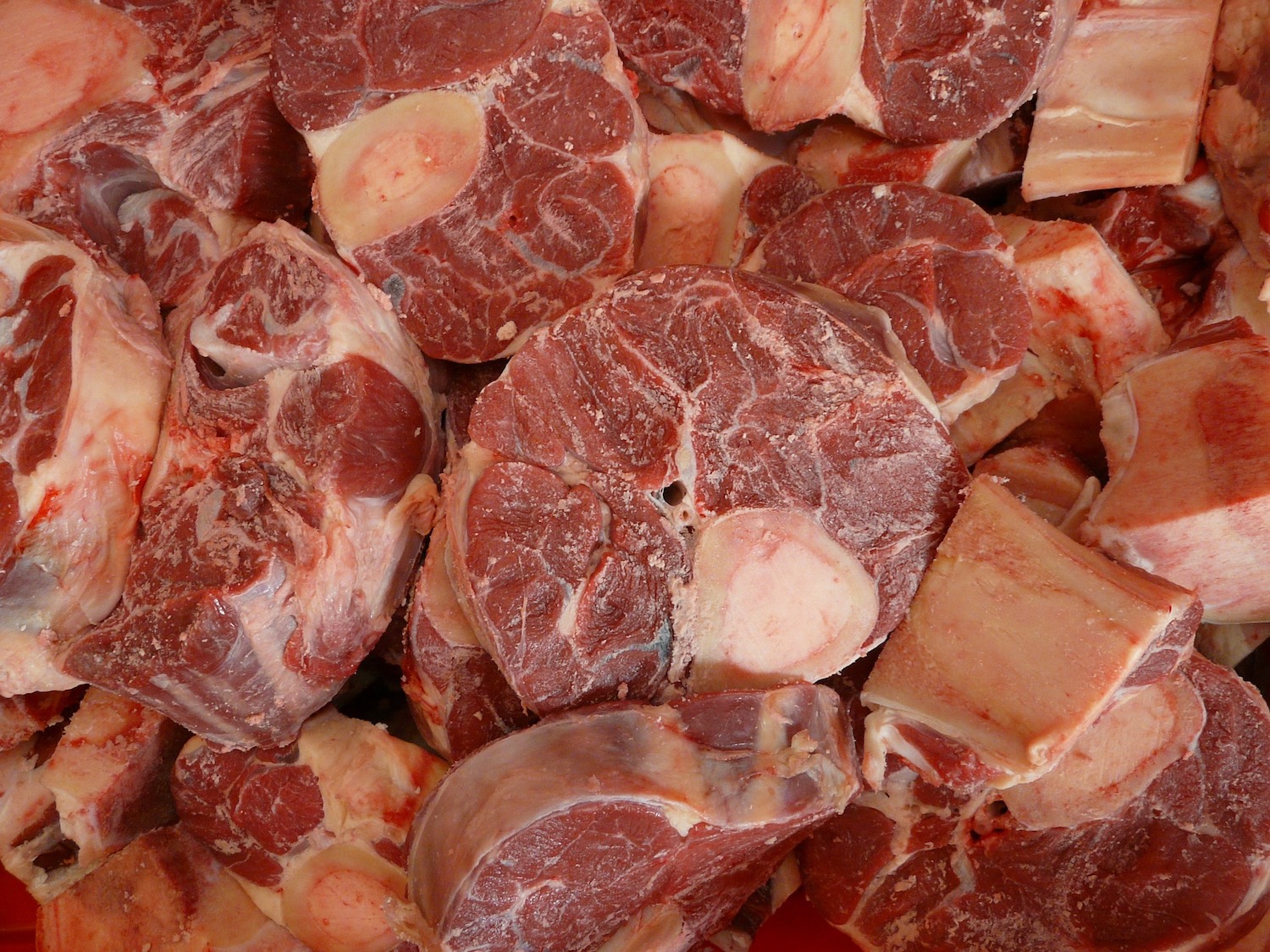
Ways to Preserve Meat Without Refrigeration
Without electric refrigeration, people had to find various ways to keep meat fresh, especially in summer. Some methods could keep it fresh a few days or perhaps a week, and other methods could preserve it for much longer.
INFORMATION BELOW FROM 1800s COOKBOOKS
TO KEEP MEAT FRESH
Where persons live a distance from market and have no fresh meat but what they kill, it is important to know how to keep it fresh.
Hang up joints of meat if not required for immediate use in any dry, shady place where there is good ventilation. They will keep fresh from two to four days and will become more tender and digestible by hanging. But in all cases, hang them with the cut side up and knuckle downward, or the reverse of the usual way. Thus the blood remains in the meat and keeps it sweet and juicy in summer.
In the summer, if you have an ice-house, you can keep it without trouble. If rubbed with salt, and pinned in a cloth, it will keep in the cellar two days. Or by lowering it down your well attached to a rope and changing the cloth every other day, it will keep good a week in hot weather.
If ice houses are not available, fresh meat may be kept for several days by the use of sour milk, grain, borax, charcoal or pepper.
PRESERVE MEAT IN MILK
Pieces of fresh meat may be placed in large stone jars and covered with sour milk* or buttermilk. They must be weighted with a clean stone to keep the meat under the surface of the liquid, and the jar placed in a cold cellar or in the running water from a spring. It is not necessary to remove the bone. The fresh meat can be preserved for a week or ten days. Milk can afterwards be fed to pigs. Before cooking, the meat should be washed thoroughly in clear water and afterwards three to five minutes in water containing a tablespoon of cooking soda to the gallon. This neutralizes the acid of the milk and make the meat more tender.
*sour milk – fresh whole milk that was left to ferment and sour by keeping it in a warm place for a day, often near a stove. Pasteurized milk may spoil rather than sour.
IN GRAIN
Cut meat in pieces, not exceeding two or three pounds in weight, and pack them down between layers of dry cornmeal or bran.
WITH BORAX
Fresh meat may be preserved by soaking it for three to five minutes in a solution of one tablespoon of borax to a gallon of water, or by rubbing it with dry powdered borax. Rinse with clear water when required for use.
WITH CHARCOAL
Rub meat thoroughly with fresh powder charcoal, which has powerful antiseptic properties. It can be readily rinsed off with clear water.
WITH PEPPER
Another way to keep meat good in summer and also keep away the flies is to dust well with pepper. An additional advantage is that the pepper is dry and helps to conserve the meat juices.
=================================================
AN ANTISEPTIC MIXTURE
Fresh meat may be preserved by laying it down in an earthenware jar and sprinkling with a mixture of salt, sugar, and saltpeter. For every pound of meat, measure one and one-half teaspoons each of salt and sugar, one-half teaspoon saltpeter,* and one-half teaspoon of black or white pepper. They should be dried, mixed. and reduced to powder in a mortar.
Now sprinkle the bottom of an earthenware jar with a thin layer of this mixture and lay down a layer of steak chopped of uniform thickness, packing tightly to cover the bottom of the jar. Sprinkle over this the mixture of antiseptic so as to cover the surface lightly. Add another layer of meat, and so on, until the jar is full.
Cover the top of the jar with a layer of cotton batting in a solution of the same mixture of antiseptics in water. Or the top of the jar may be covered with a layer of melted tallow, lard, or paraffin to keep out the air.
Put on the lid of the jar tightly and set it in a cellar, spring house, or other cold place. When the meat is required for use, rinse and scald* it. Soak the cotton batting in the covering solution of antiseptic and packet down closely over the remaining meat as before, or add more melted fat to completely cover the meat.
*saltpeter – potassium nitrate, an early food preservative, but rarely used now.
*scald – to heat liquid almost to a boil, until bubbles begin to form around the edge.
TO PICKLE MEAT
To pickle meat, put one gallon of water into a large saucepan. Add one and one-half pound salt, six ounces brown sugar, and one ounce saltpeter. Put it on the fire, bring it to the boil, and let it boil for five minutes, keeping it well skimmed. Strain it into a large tub or basin. When the pickle is quite cold, meat can be put into it.
SALT MEAT
Meat that is to be salted should lie an hour in cold water, rubbing well any part likely to have been fly-blown.* When taken out of the water, wipe it quite dry, then rub it thoroughly with salt, and throw a handful over it besides.
*fly-blown – contact with flies, their eggs, or larvae
FREEZE MEAT
In cold climates and in winter, meats may be preserved indefinitely by allowing it to freeze. But it must not be permitted to freeze and thaw frequently, and must not be thawed out too quickly when required for use.
To preserve meat by freezing, first expose it to the weather until thoroughly frozen through and through. Wrap in waxed paper or cover with a cloth coated with shellac or other varnish and pack in an ordinary flour barrel between layers of hay or straw, pressing the whole in tightly and as solidly as possible. Place the barrel in a packing case and surround with a layer of five or six inches of dry sawdust.
To thaw frozen meat when required for use, place it in a moderately warm room at a distance from the fire, and allow it to thaw gradually. Or better still, soak it two or three hours in cold water. If thawed too quickly, it will be unfit for use. The best way to boil it is to put it in cold water and boil it gently, with just water enough to cover it, as it hardens by furious boiling.
TO KEEP SUET FOR SEVERAL MONTHS
Chop the suet* as fine as for mince pies or puddings. Then add a tablespoon of salt to three tablespoons of suet. Mix all well together and put it in jars. Keep it tied up close, as exposure to the air makes it strong. The suet should be soaked an hour before you wish to use it to remove the salt taste.
Also, suet keeps good all the year round if chopped and packed down in a stone jar, covered with molasses.
*suet – the hard white fat on the kidneys and loins of cattle, sheep, and other animals, used to make foods including puddings, pastry, and mincemeat.
=================================================
It’s interesting to read how people cooked and preserved foods in the 1800s. Here’s a modern book on preserving meat and other foods as well.
=================================================
Do you grow or raise your own food? How do you preserve it? Leave a comment below.
=================================================


4 thoughts on “Ways to Preserve Meat Without Refrigeration”
This is incredibly cool information! I was just told about how milk will let you keep meat without refrigeration for a couple of days. That inspired a Google search which led me here. Thank you for sharing this!
Thanks for telling me how you found my site.
Somehow meat powdered with borax doesn’t sound all that yummy. 🙂 Very interesting article. I’d never thought much about how meat was preserved before now.
All I knew about was smoking or salting meat.